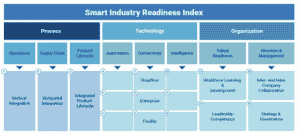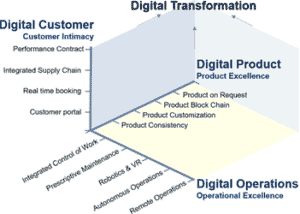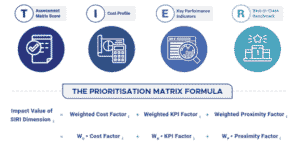My personal digital transformation project
Maybe you recognize the following situation: you are in the supermarket for daily shopping. At the entrance, you are welcomed by attractive product displays. You act like you are not interested, but in reality, you are curious. Maybe there is a good deal for you. Suddenly you are attracted to the smoke detectors. Instantly you think, I need this at home. You buy the smoke detectors and test them while irritating your family with the noise. Once you have mounted the detectors, you are proud to have “saved” your family from any pending danger from fire and smoke. This is what happened to me.
Questions and answers
Six months ago, four years after buying the detectors, I asked myself if the three smoke detectors provided sufficient protection to my family (my baseline). What do I want to protect my family (my target)? And how much money do I want to spend (my budget)?. I took my time to answer these questions, and I concluded the following:
- No, the three smoke detectors are not sufficient to protect my family (baseline)
- I want to protect my family against smoke, carbon monoxide and theft (target)
- I need a Do It Yourself solution with no subscription (user requirement)
- The system has to be certified against sabotage like radio jamming the wireless signal between the sensors and the alarm base station (technical specifications)
- My maximum budget is 1.200 Euro (budget)
After three weeks of study, I decided to select the Ajax system (a relatively new company from Ukraine). I selected this system because it was the only Do It Yourself EN 50131 certified system, burglar- fire – gas detectors are integrated controlled by one Android or OS app, and the total price was within my budget.
What is your Baseline?
You can consider my small transformation a good metaphor for a company’s digital transformation project. Before a company starts with any transformation project, it is essential to understand the baseline and, in this particular case, the baseline for digital transformation within manufacturing or “Smart Manufacturing”. In other words, what is my current Smart Manufacturing status? To determine the baseline, you need a comparison against other baselines in your industry; without this, it is difficult to understand your company’s current status or digital maturity compared to your peers.
We use the IEC61508 as the reference for safety, and for cybersecurity, we use the IEC62443. Another famous reference is the Solomon index designed explicitly for the refinery industry. We didn’t have a reference for Smart Manufacturing for a long time until recently.
In 2017, the Singapore Economic Development Board (EDB), in partnership with a network of leading technology companies, consultancy firms, and industry and academic experts, created the Smart Industry Readiness Index (SIRI).
Three layers
SIRI comprises a suite of frameworks and tools to help manufacturers assess the company Smart Manufacturing baseline maturity regardless of size and industry. The SIRI Framework consists of three layers
- The three fundamental building blocks of Industry 4.0: Are Process, Technology, and Organisation.
- Underpinning the building blocks are eight pillars, which represent critical aspects that companies must focus on to become future-ready organizations.
- The third and final layer comprises 16 dimensions that companies should reference when evaluating the current maturity levels of their facilities.

The 16 dimensions serve as a checklist to ensure that all aspects of Smart Manufacturing are formally considered. The same framework is used as a blueprint for companies to sustain and refine their initiatives over a multi-year period.
During the assessment, the certified SIRI consultant (Yokogawa has over 20 certified consultants globally) will rank the maturity of all 16 dimensions together with the customer team. The maturity ranking happens through a bandwidth of 0 – 5, where 0 represents immature, and 5 is very mature. The assessment outcome is called the matrix score and is used as a benchmark to calculate the impact value per dimension (in total, 16 impact values are calculated).
The impact values represent the transformation impact value per dimension and are determined through the Prioritization Matrix formula, illustrated as follows:
The formula comprises three key factors – Cost, Key performance indicators (KPIs) and the company’s Proximity to the industry best-in-class. The Cost Factor represents the company’s cost profile; the KPI factor is the 5 most important KPIs for the company to meet their objectives. The Proximity factor compares the company matrix score of the 16 dimensions and the industry’s best-in-class score. All the data as just mentioned plus the planning horizon (are your objectives focussed on short, midterm or long) are entered into the SIRI tool and database. The outcome of the SIRI tool is the impact values for all 16 dimensions. The three most significant calculated impact values (representing 3 dimensions) are considered the starting point of your digital transformation journey since these 3 dimensions will have the highest impact in transforming your company and meeting your objectives.
Part of the SIRI is the 3B Maturity Benchmark, providing a high-level reference point for a factory or a plant to be Best-in-Class, in the Broad Middle, or Lagging in the Bottom for the sixteen dimensions. This gives the global manufacturing community a whole-of-manufacturing sector benchmark. The 3B Maturity Benchmark is currently derived from more than 700 completed SIRI Assessments, and it is continuing to grow rapidly.
What is your target?

The value-driven operating model by Michael Treacy & Fred Wiersema can help you determine your objective for the transformation and the KPIs to meet your objective. The value-driven operating model differentiates between Product Leadership (Digital Product), Operational Excellence (Digital Operations) and Customer Intimacy (Digital Customer). All three are important, but with your company’s digital transformation, you must set your targets and priorities because it is impossible to be the best in everything primarily due to budget and resource constraints.
Priority is Digital Operations
For commoditized industries like bulk chemicals, the priority is Digital Operations, while for niche markets like special chemicals, Digital products may have the highest priority. As you can see in the figure, the roadmap for Digital Product and Digital Operations is different. Indeed, with the introduction of Industry 4.0, companies need to make tough strategic choices to be prepared for the future. Once a company has set their priority and knows the three dimensions with the highest impact value, specific targets for the transformation can be set.
What is your budget?
With so many different “moving people, process and technology parts” in your company, digital transformation requires a solid foundation to build. Including a budget and resources that accurately reflect the initiative’s scale and complexity while remaining achievable and realistic.
From my experience, transformation starts at the top with a clear vision and strategy, including the objectives. Next, you need a systematic approach to identify opportunities and high impact values. SIRI helps you to systematically identify your opportunities. With the objectives and opportunities in mind, you can develop your roadmap and calculate your required budget and resources.
My transformation project had only one objective to protect my family with a simple baseline. However, I firmly believe there are synergies between my transformation project experience and manufacturing digital transformation projects. In the end, we want the same; the best interest of our family or colleagues and stakeholders in the case of manufacturing.
Maturity models in digital transformation – an interview with Dr. Violett Zeller





